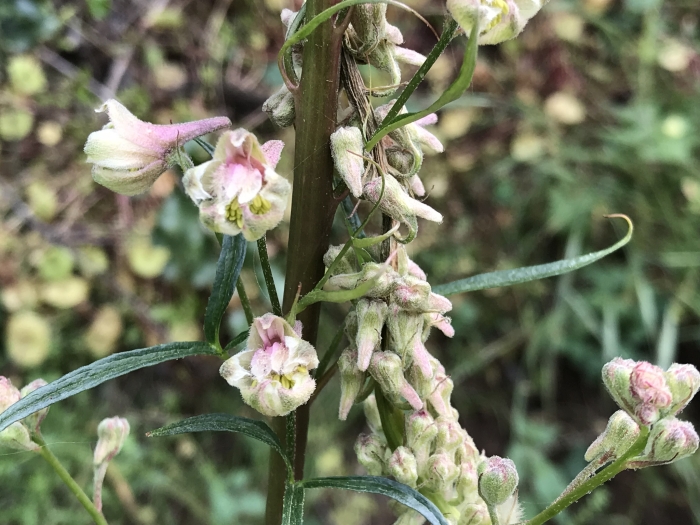California Larkspur
(Delphinium californicum)
California Larkspur (Delphinium californicum)
/
/

rappman
CC BY 4.0
Image By:
rappman
Recorded By:
Copyright:
CC BY 4.0
Copyright Notice:
Photo by: rappman | License Type: CC BY 4.0 | License URL: http://creativecommons.org/licenses/by/4.0/ | Rights Holder: rappman | Publisher: iNaturalist | Date Created: 2018-04-27T22:37:47Z |



















































Estimated Native Range
Summary
Delphinium californicum, commonly known as California Larkspur or Coast Larkspur, is a semi-deciduous perennial herb that thrives in the coastal sage scrub and chaparral of Central California, particularly in areas with cool, moist winters and dry summers. It is endemic to California, where it contributes to the region’s biodiversity. This wildflower features tall, erect stems that can exceed one meter in height, often approaching two meters. The top of the stem boasts a large inflorescence, typically containing over 50 flowers, each borne on a pedicel several centimeters long. The sepals form a forward-pointing cup at the mouth of the tubular flower, with the longest sepals reaching about a centimeter and the spur extending up to two centimeters. Flower color ranges from white to greenish-white to light lavender, blooming from late spring to early summer.
California Larkspur is valued for its vertical accent in garden designs and its ability to attract pollinators such as bees and butterflies. It is often used in native plant gardens, borders, and wildflower meadows. While it prefers full sun to part shade, it is drought-tolerant once established, requiring only low amounts of water. It thrives in well-draining soils and can adapt to a variety of soil types, though it prefers those with medium drainage. Gardeners should be aware that all parts of the plant are toxic if ingested, and it should be handled with care to avoid skin irritation.CC BY-SA 4.0
California Larkspur is valued for its vertical accent in garden designs and its ability to attract pollinators such as bees and butterflies. It is often used in native plant gardens, borders, and wildflower meadows. While it prefers full sun to part shade, it is drought-tolerant once established, requiring only low amounts of water. It thrives in well-draining soils and can adapt to a variety of soil types, though it prefers those with medium drainage. Gardeners should be aware that all parts of the plant are toxic if ingested, and it should be handled with care to avoid skin irritation.CC BY-SA 4.0
Plant Description
- Plant Type: Herb
- Height: 2-7 feet
- Width: 0.286-1 feet
- Growth Rate: Moderate
- Flower Color: Purple, White
- Flowering Season: Spring
- Leaf Retention: Semi-Deciduous
Growth Requirements
- Sun: Full Sun, Part Shade
- Water: Low
- Drainage: Medium
Common Uses
Bee Garden, Bird Garden, Butterfly Garden, Deer Resistant, Hummingbird Garden, Rabbit Resistant, Showy Flowers
Natural Habitat
Coastal sage scrub and chaparral in Central California
Other Names
Common Names: Coast Larkspur
Scientific Names: , Delphinium californicum, Delphinium californicum f. longipilis, Delphinium californicum var. laxiusculum, Delphinium californicum var. scapigerum, Delphinium exaltatum var. californicum,
GBIF Accepted Name: Delphinium californicum Torr. & A.Gray